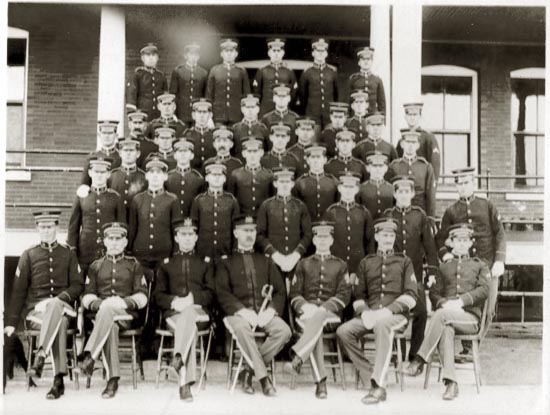
Company G, 11th Infantry, Ft. D.A. Russell, approx. 1909
Photo courtesy Stephen Sexton, whose father Stephen M. Sexton, a musician, is in the
above photo (fourth row, third from right).
As indicated on the previous page, the Eleventh Infantry returned to Fort D. A. Russell in
1904 following the Philippine Insurrection. The Eleventh Infantry was originally organized
by Order of President Lincoln on May 14, 1861. Among its original field commanders
was Major Frederick Steele, after whom Fort Fred Steele east of Rawlins is named. Following the
Civil War, the unit was decommissioned but reorganized in 1869 and saw duty in
Texas until 1876 when it was reassigned to the Department of Dakota. There some of its
units assisted in the construction of Fort Custer, Montana.
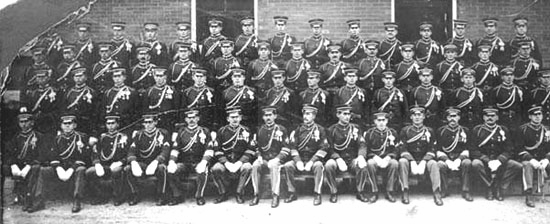
Company H, 11th Infantry, Ft. D. A. Russell, approx. 1909
Photo courtesy Cathy Conrad, Indiana Army National Guard, Ret., whose grandfather,
Sgt. James Burton Houpt (1880-1942) is in the above photo (sixth from the right, looking
slightly to the viewer's right and sitting next to the soldier who is slouching.).
For full size image of left half of photo click here. For
right half of photo, click here.
By 1884, the Indian Wars were recognized as being essentially over. Thus, there began a program of
converting the army from one intended as defending against Indian attacks to an army whose
primary purpose was to defend the United States against foreign attack. Army units were concentrated
along the borders of the country and at major railroad junctions. In 1887, the
11th Infantry was rotated to Madison Barracks. During the same period the 9th Infantry was
primarily stationed at D. A. Russell and other forts in Wyoming.
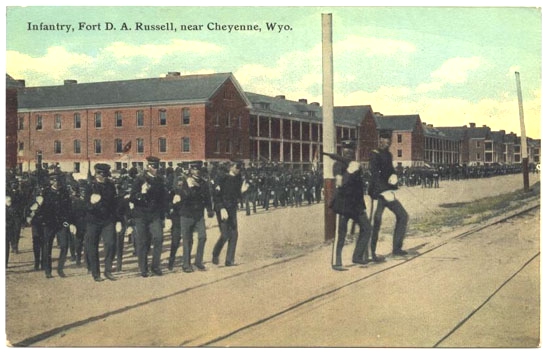
Infantry, approx. 1910
In 1898, War with Spain broke out. The 11th
was transferred to Port Tampa for further duty in Puerto Rico where it served until
1900. With the outbreak of the Philippine Insurrection discussed on the preceding page, the
11 was transferred to the Philippines where it served first on Leyte and later at
Manila. In 1904, the 11th was stationed at D. A. Russell until it was transferred to Cuba in October of 1906.
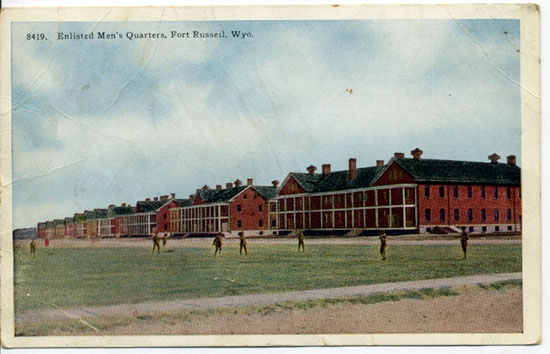
A baseball game in front of Infantry Barracks, 1910
Following service in Cuba the regiment was returned to D. A. Russell where it remained
primarily stationed with the exception that some troops from D. A. Russell were moved to
the Mexican border in response to the revolutions in Mexico.
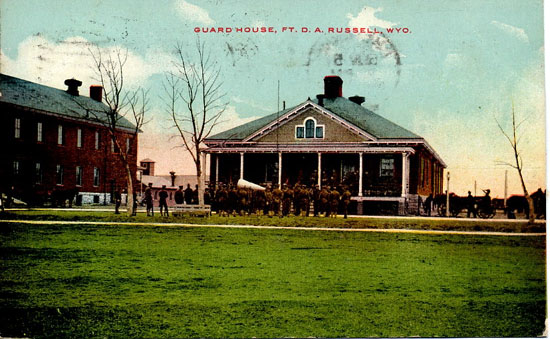
Guard House, Ft. D. A. Russell, approx. 1909
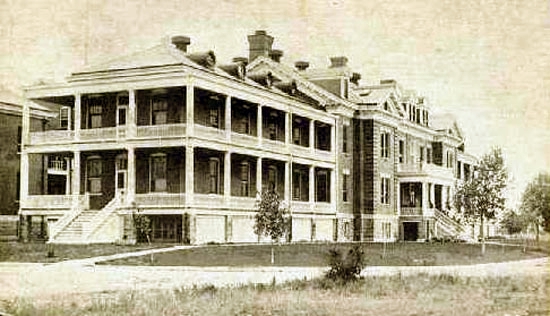
Hospital, Ft. D. A. Russell, undated
In 1930, President Hoover changed the name of Fort D. A. Russell to Fort F. E. Warren, after
Congressional Medal of Honor recipient and former Governor and Senator F. E. Warren. Warren
received the Medal of Honor as a result of his volunteering in an assault upon
Port Hudson, Louisiana, on May 27, 1863. In the assault, Brig. General Thomas W. Sherman lost his leg to
Confederate gunfire and his second in command Brig. General Neal Dow
was severely wounded. In the final assault of the day, Colonel James O'Brien signalled for a
charge. Less than a dozen men responded. Within 30 seconds, Colonel O'Brien was killed. It then
became necessary for the Union Army to settle into a seige that lasted until July 9 when the
Confederate fortifications finally fell. Contrary to popular belief, it was not the
fall of Vicksburg to Grant that opened the Mississippi to Union navigation, but the fall of
Port Hudson five days later. Following World War II, the Fort Warren became an
Air Force Base.
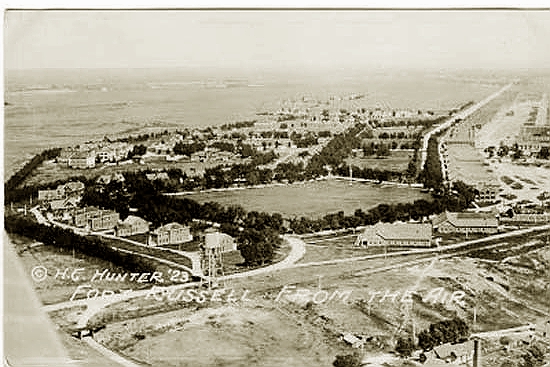
Aeroplane view Ft. D. A. Russell, 1923
Music this page:
The Field Artillery Song
by Lt. Edmund L. "Snitz" Gruber
5th Artillery
Over Hill, over dale
We have hit the dusty trail,
And the Caissons go rolling along.
In and out, hear them shout,
Counter march and right about,
And the Caissons go rolling along.
Fot it hi! h1! hee!
In the field artillery,
Shout out your numbers loud and strong,
And where e'er you go,
You will always know
That the Caissons go rolling along."
Edmonun L. Gruber (1879-1941) was a graduate of West Point and served at
Fort D. A. Russell from 1904 to 1906 before being assigned to the Philippines where the song was
written in March 1908 at Camp Stotsenburg. The Army has since changed the lyrics and to some extent
the melody. The current lyrics honor the entire Army including those who served at
Valley Forge, at Litte Bighorn, the Spanish American War and World War II. Lt. Gruber ultimately became a brigadier general.
Next Page, Fort D. A. Russell Target and Maneuver Range.
|